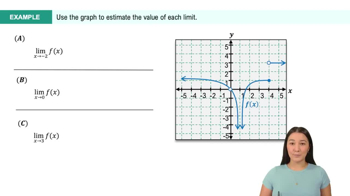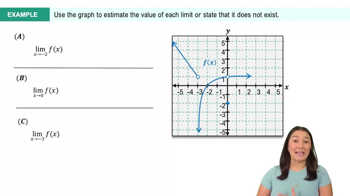Table of contents
- 0. Functions7h 52m
- Introduction to Functions16m
- Piecewise Functions10m
- Properties of Functions9m
- Common Functions1h 8m
- Transformations5m
- Combining Functions27m
- Exponent rules32m
- Exponential Functions28m
- Logarithmic Functions24m
- Properties of Logarithms34m
- Exponential & Logarithmic Equations35m
- Introduction to Trigonometric Functions38m
- Graphs of Trigonometric Functions44m
- Trigonometric Identities47m
- Inverse Trigonometric Functions48m
- 1. Limits and Continuity2h 2m
- 2. Intro to Derivatives1h 33m
- 3. Techniques of Differentiation3h 18m
- 4. Applications of Derivatives2h 38m
- 5. Graphical Applications of Derivatives6h 2m
- 6. Derivatives of Inverse, Exponential, & Logarithmic Functions2h 37m
- 7. Antiderivatives & Indefinite Integrals1h 26m
1. Limits and Continuity
Introduction to Limits
Problem 12a
Textbook Question
Given the function f(x)=−16x2+64x, complete the following. <IMAGE>
Find the slopes of the secant lines that pass though the points (x,f(x)) and (2,f(2)), for x=1.5,1.9,1.99,1.999, and 1.9999 (see figure).
 Verified step by step guidance
Verified step by step guidance1
First, evaluate the function f(x) at the given point x = 2. Substitute x = 2 into the function f(x) = -16x^2 + 64x to find f(2).
Next, evaluate the function f(x) at each of the specified x-values: x = 1.5, 1.9, 1.99, 1.999, and 1.9999. Substitute each x-value into the function to find f(x) for each case.
For each x-value, calculate the slope of the secant line that passes through the points (x, f(x)) and (2, f(2)). Use the formula for the slope of a secant line: m = (f(x) - f(2)) / (x - 2).
Substitute the values of f(x) and f(2) into the slope formula for each x-value to find the slope of the secant line.
Repeat the calculation for each x-value to determine the slopes of the secant lines for x = 1.5, 1.9, 1.99, 1.999, and 1.9999.
Recommended similar problem, with video answer:
 Verified Solution
Verified SolutionThis video solution was recommended by our tutors as helpful for the problem above
Video duration:
7mPlay a video:
Was this helpful?

 6:47m
6:47mWatch next
Master Finding Limits Numerically and Graphically with a bite sized video explanation from Callie
Start learning





